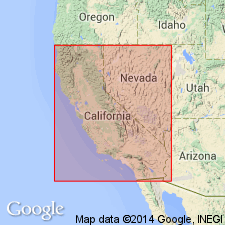
- Usage in publication:
-
- Santa Lucia granite
- Modifications:
-
- Original reference
- Dominant lithology:
-
- Granite
- AAPG geologic province:
-
- California Coast Ranges province
Summary:
[Pg. 1-18]. Santa Lucia granite. Age is pre-Cretaceous, forms main ridge of Santa Lucia Range.
Source: US geologic names lexicon (USGS Bull. 896, p. 1923-1924).
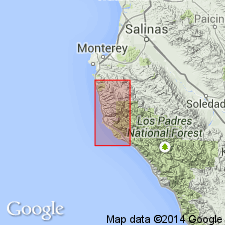
- Usage in publication:
-
- Santa Lucia quartz diorite
- Modifications:
-
- Redefined
Summary:
Santa Lucia quartz diorite. The term Santa Lucia was first applied by Lawson (1893) to the porphyritic granite in vicinity of Carmel Bay, but the porphyritic variety that he describes is only of local extent in Point Sur quadrangle. As it apparently grades into the main quartz diorite mass of the region, and hence is probably a differentiate of the quartz diorite, the name Santa Lucia is retained for the entire plutonic mass. Intrudes Sur series.
Source: US geologic names lexicon (USGS Bull. 896, p. 1923-1924).
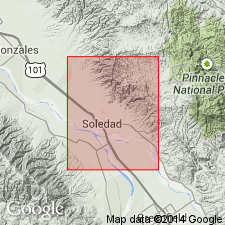
- Usage in publication:
-
- Santa Lucia quartz diorite
- Modifications:
-
- Age modified
Summary:
Evidence is that Santa Lucia quartz diorite has intruded and is later than Santa Lucia granite of Gavilan [Gabilan] Range, and presumably both intrusives cut Sur series.
Source: US geologic names lexicon (USGS Bull. 896, p. 1923-1924).
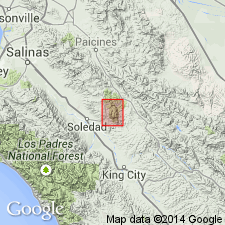
- Usage in publication:
-
- Santa Lucia [granite?]
- Modifications:
-
- Areal extent
- AAPG geologic province:
-
- San Joaquin basin
Summary:
Term Santa Lucia is applied to granitic rocks of Gavilan [Gabilan] Range, since they are considered to be generally related to the granites of Santa Lucia Range. Age is pre-Franciscan.
Source: US geologic names lexicon (USGS Bull. 1200, p. 3465).
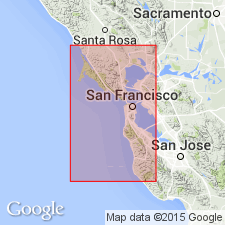
- Usage in publication:
-
- Santa Lucia granodiorite
- Modifications:
-
- Overview
Summary:
Pg. 118. Several names have been given to the ancient crystalline complex in San Francisco Bay Counties. Originally it was called Santa Lucia series, a name applied to the crystalline complex as a whole. Later, name Sur schists was given to the metamorphosed sedimentary and volcanic rocks, and name Santa Lucia was retained for the plutonic rocks. It has become customary to call all schist the Sur series, all crystalline limestones, marbles, and dolomites, Gabilan limestone, and all plutonic rocks the Santa Lucia granodiorite. These names are essentially petrographic and not formational in usual sense since rocks of very different ages might be included under any one of the names.
Source: US geologic names lexicon (USGS Bull. 1200, p. 3465).
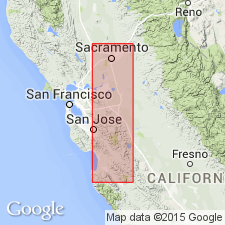
- Usage in publication:
-
- Santa Lucia granodiorite
- Modifications:
-
- Age modified
- Geochronologic dating
Summary:
Pg. 9. Potassium-argon (K-Ar) age determinations on some granitic rocks given. Sample of Santa Lucia granodiorite gave age 81.6 Ma. Dated specimen was collected by Lawson from quarry at Carmel Cove on Carmel Bay.
Source: US geologic names lexicon (USGS Bull. 1200, p. 3465).
For more information, please contact Nancy Stamm, Geologic Names Committee Secretary.
Asterisk (*) indicates published by U.S. Geological Survey authors.
"No current usage" (†) implies that a name has been abandoned or has fallen into disuse. Former usage and, if known, replacement name given in parentheses ( ).
Slash (/) indicates name conflicts with nomenclatural guidelines (CSN, 1933; ACSN, 1961, 1970; NACSN, 1983, 2005, 2021). May be explained within brackets ([ ]).

